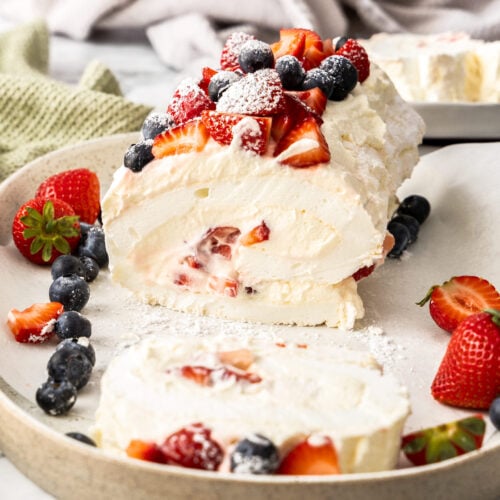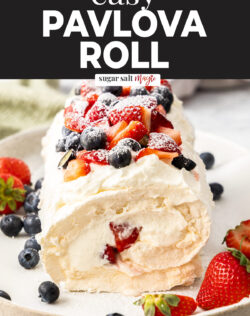Why you’ll love it
This pavlova roll is the perfect dessert when you want something light, sweet and beautiful to serve at the end of a special meal, or when you need a pavlova on short notice (you can be serving roulade within 1 hour of starting it).
Made the same way as a pavlova but cooked more quickly in a sheet pan, instead of slowly in a big mound, pavlova roll (also known as meringue roulade) stays soft and marshmallow-like, just like the soft inside of a pavlova.
Rolled up with a simple chantilly cream (sweetened vanilla whipped cream) and berries, it’s the ultimate in quick but beautiful summer desserts. It’s quick, easy but still impressive.
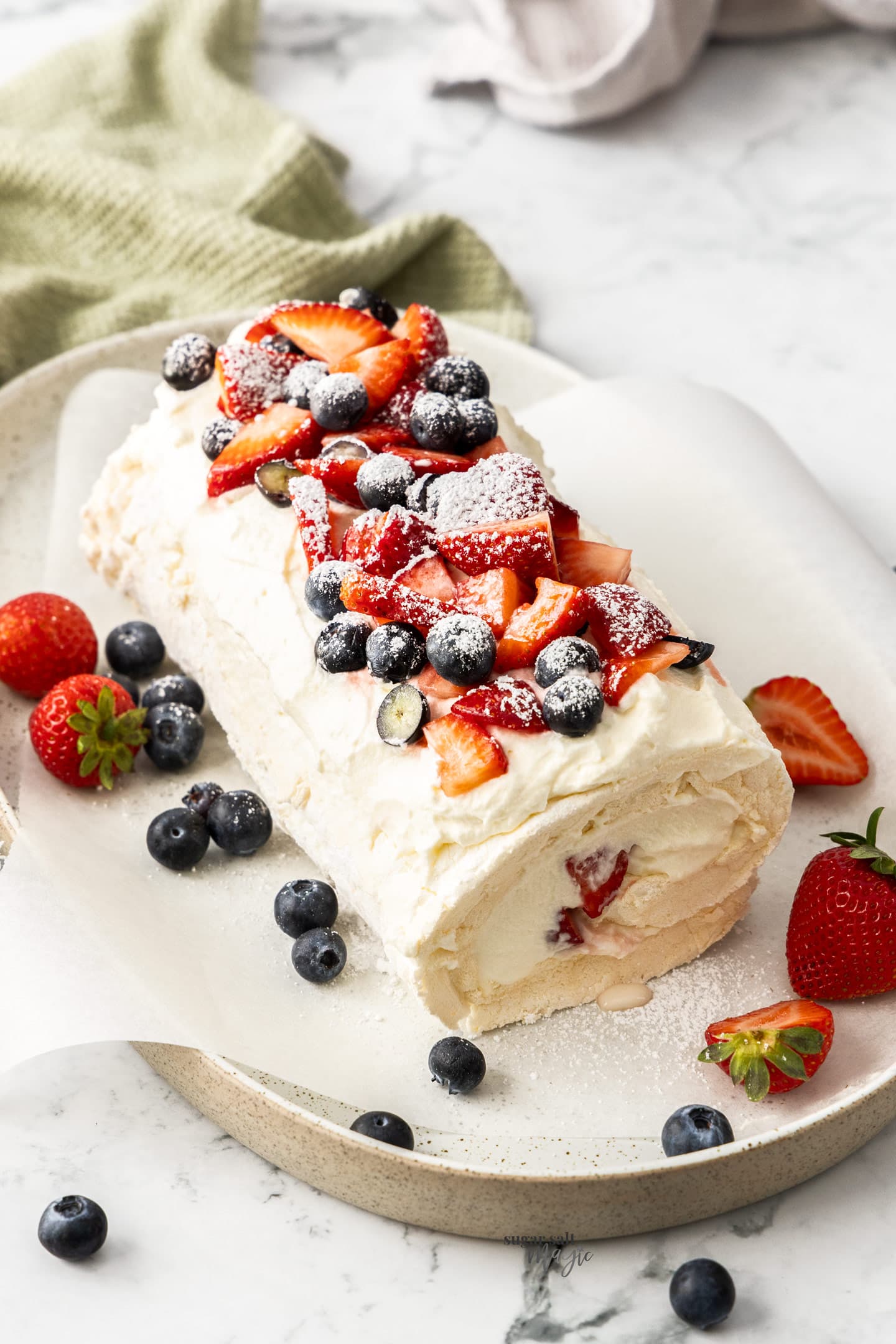
Never Miss a Recipe!
Get the latest recipes straight to your inbox!
What is a pavlova roll?
Also known as a meringue roulade or a pavlova roulade, a pavlova roll is a soft, light-as-air, melt-in-the-mouth, meringue that is filled with cream and berries and rolled up (roll cake style). This dessert, popular in Australia and New Zealand especially, is a take on the more traditional pavlova – the main difference being there is no crispy outside on a pavlova roll.
While it’s delicious any time, meringue roulade is perfect in the summertime since it’s served cool and at its most glorious when served with fresh summer berries. You could absolutely use winter fruits too and serve it in winter – try poached pears or cinnamon apples – however the roulade itself can’t be served warm or the cream inside will melt.
Ingredients in pavlova roulade
Pavlova roll uses the same simple ingredients as a traditional pavlova. The meringue is made using egg whites, sugar, vinegar and cornflour (cornstarch). Make sure to use fresh egg whites for the best result in this meringue roulade.
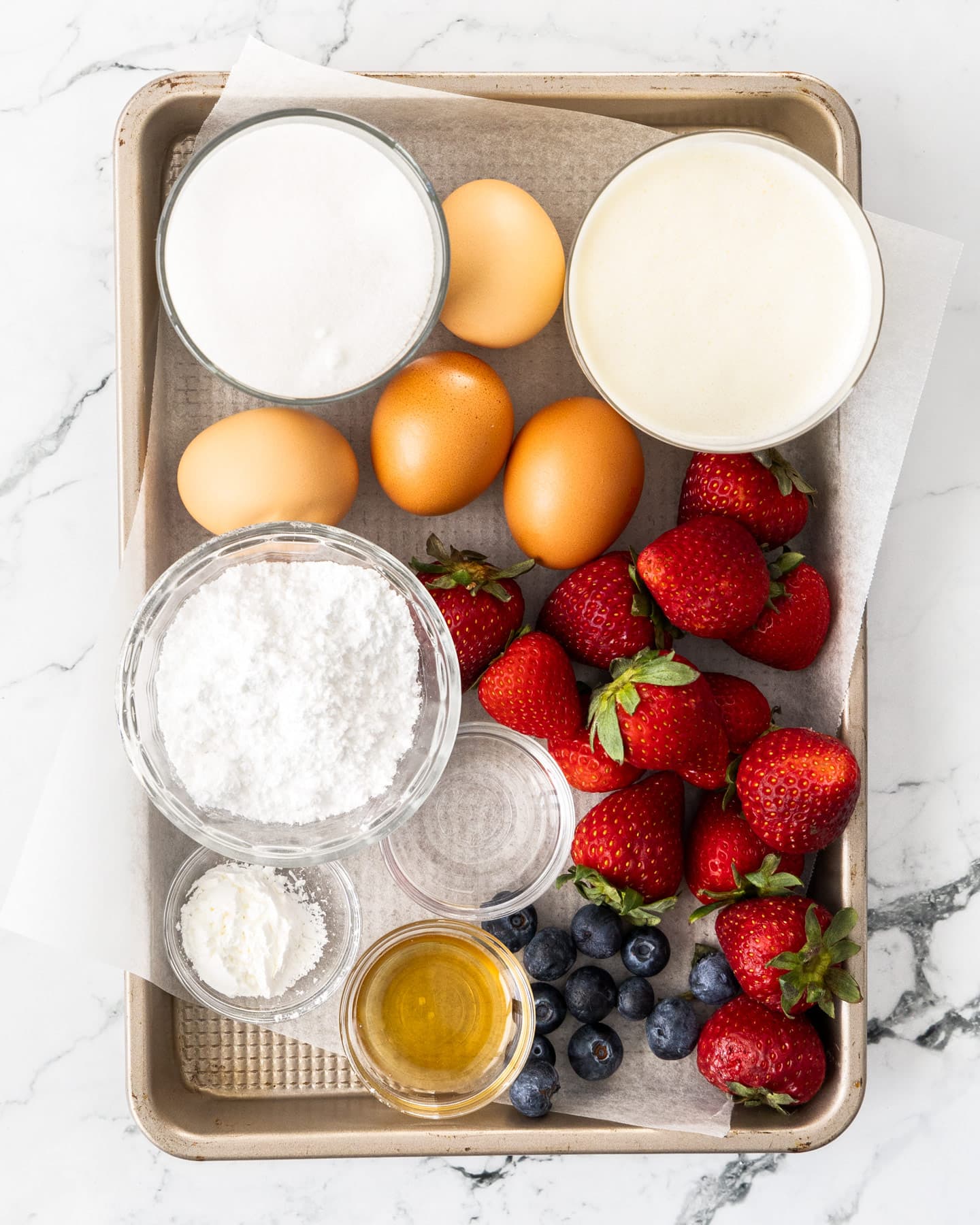
Jump to the recipe for full ingredients and instructions.
Egg whites: Use large room temperature egg whites and make sure to use fresh eggs. This will help the meringue to be more stable and malleable enough to roll. When you separate the eggs, make sure not to get any yolk in them or they won’t whip up properly and you’ll need to start again.
Caster sugar: Use caster sugar (superfine sugar) in the meringue. This ensures the sugar dissolves before you overbeat the egg whites. If you only have granulated on hand, just give it a blitz in your food processor until it’s very fine. Don’t use icing sugar / powdered sugar in the meringue.
Vinegar: A little white vinegar helps to create a stable meringue. You can swap it for lemon juice if you prefer.
Cornflour / cornstarch: Known in some places as cornstarch, cornflour is that soft, fine white flour that is often used for thickening sauces. In meringue, it is used to create that soft, melt-in-the-mouth marshmallow texture.
Vanilla: I rarely add flavouring directly to a meringue roulade or pavlova as sometimes it can cause the meringue to discolour, however, I do add some vanilla extract to the whipped cream. Don’t use vanilla essence which is a synthetic flavouring and just doesn’t taste as good.
Cream: Thickened cream, whipping cream, heavy cream or heavy whipping cream – whatever you call it you’re after a full fat cream (about 35% milk fat or more) that will whip up light and airy. In this recipe the cream is turned into chantilly cream by adding a little sugar and vanilla.
Fresh fruit: Pavlova roll is often served with loads of fresh berries like strawberries and blueberries folded through the cream and layered on top. You can use any berries like raspberries or blackberries too or any other fresh fruit you like. Try mango, peaches, cherries or kiwi fruit and choose a mix of fruits.
How to make a pavlova roll
So, how do you make a pavlova roll? Push it down a hill! Haha, sorry, couldn’t resist.
Making a pavlova roll or meringue roulade is actually a really simple process, easier than making a pavlova and it’s quicker too. Using a stand mixer means you can be hands-off while the meringue is whipping (making a cuppa instead maybe).
For this pavlova roulade recipe, I macerate the strawberries but you can leave the macerating step out and just add the strawberries fresh.
Jump to the recipe for full ingredients and instructions.
How to make meringue for meringue roulade
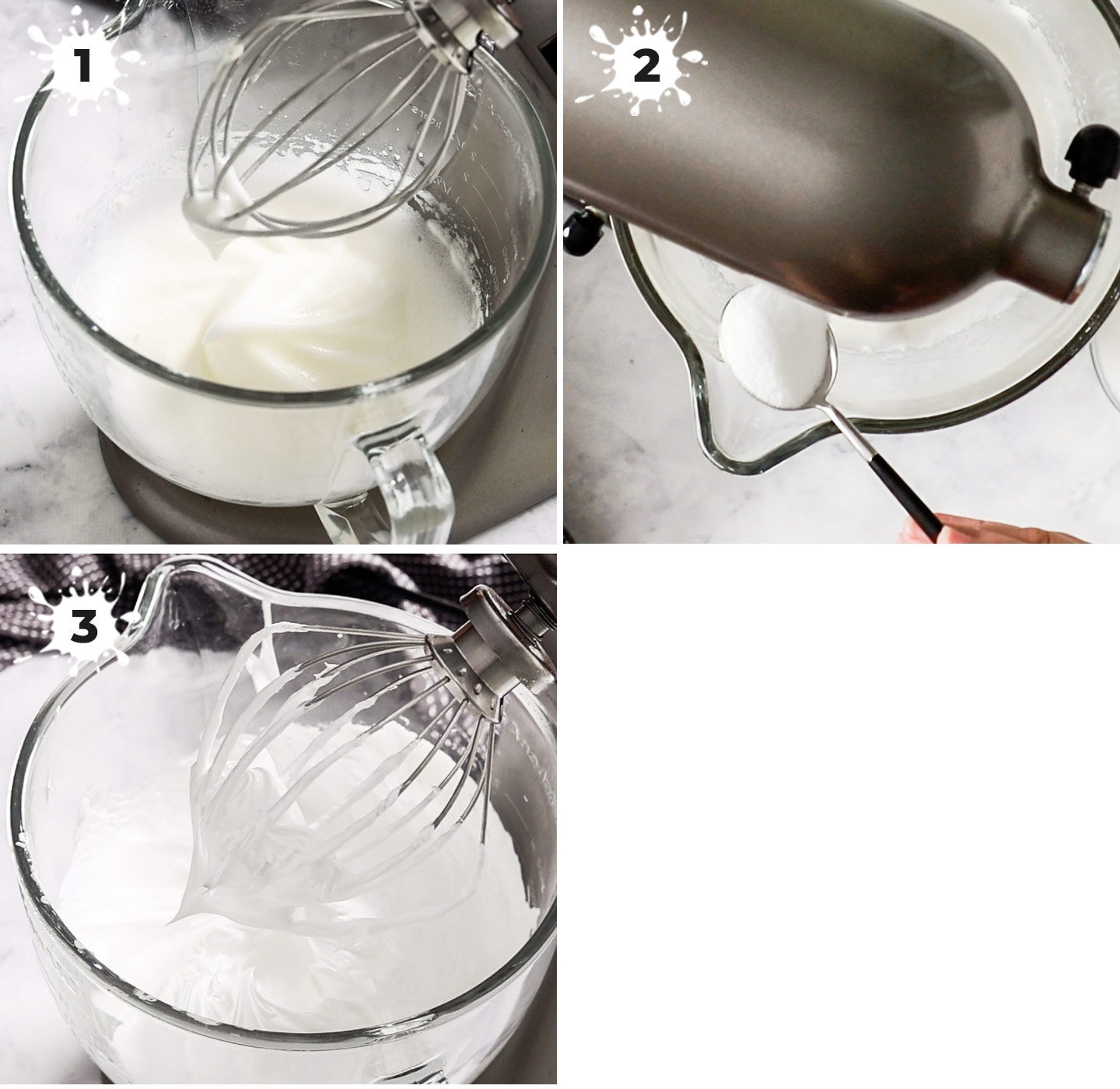
- Start by whipping egg whites on medium-high speed until they get to soft peak stage (photo 1). It’s ok if they hit stiff peaks but don’t let them go past that.
- Now add the sugar, just 1 tablespoon at a time (photo 2) and counting to 10 between each. Do this on low-medium speed. Adding the sugar slowly is essential so that you don’t knock out the air you’ve just whipped into the egg whites.
- Now give it a good beat until it’s smooth, white and glossy with stiff peaks (photo 3) then add the cornflour and vinegar and beat that in.
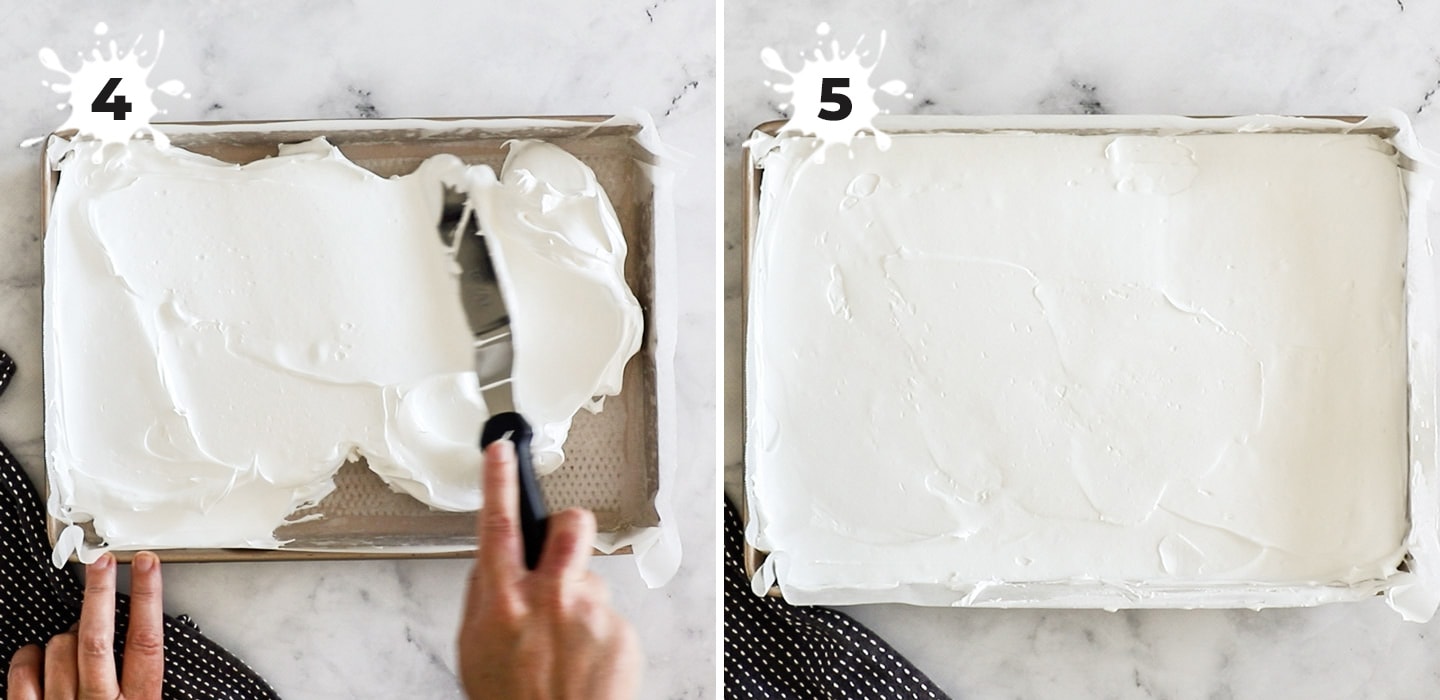
- Spread the meringue into your lined baking tray (photo 4), all the way to the edges and so the top is flat and level (photo 5).
- Bake the meringue for 15 minutes at 160C/320F until it just begins to turn golden top.
While it bakes, you can wash and slice your berries! And make sure to get the items you’ll need for the next step.
Flipping the meringue out
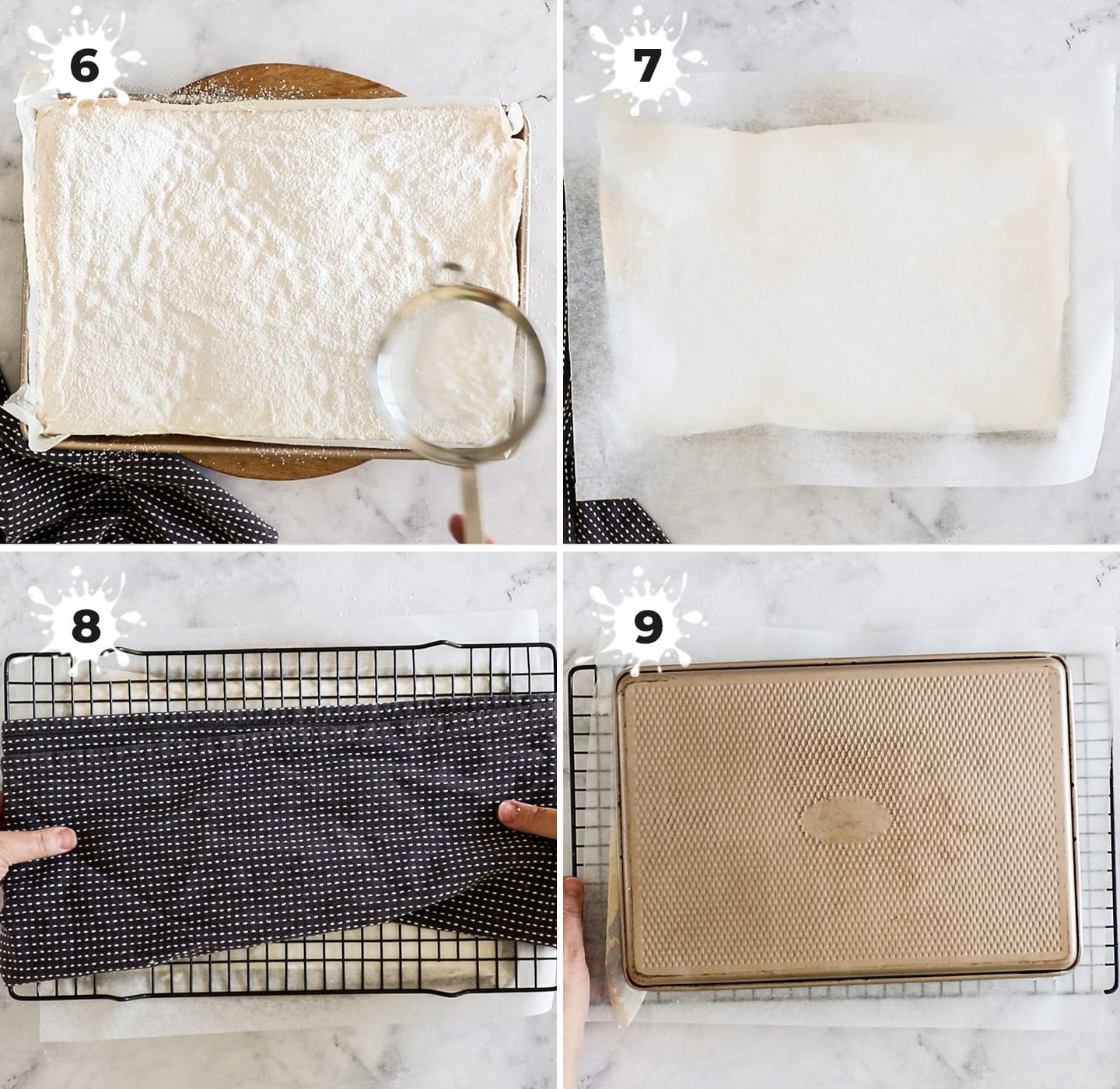
- As soon as the meringue comes out of the oven, dust it generously with icing sugar (photo 6).
- Lay a sheet of baking paper over the top (photo 7).
- Lay a wire cooling rack on top (upside down – aka feet up, flat side down).
- Grab the whole lot with a tea towel (photo 8) so you don’t burn your hands and flip it over so the baking tray is on top (photo 9).
- Now, you can simply remove the baking tray and peel back that top layer of baking paper.
Let the meringue cool for at least 20-30 minutes. It needs to be room temp before you add the cream but you can get to work on whipping the cream and macerating strawberries while you wait.
Filling the pavlova roll
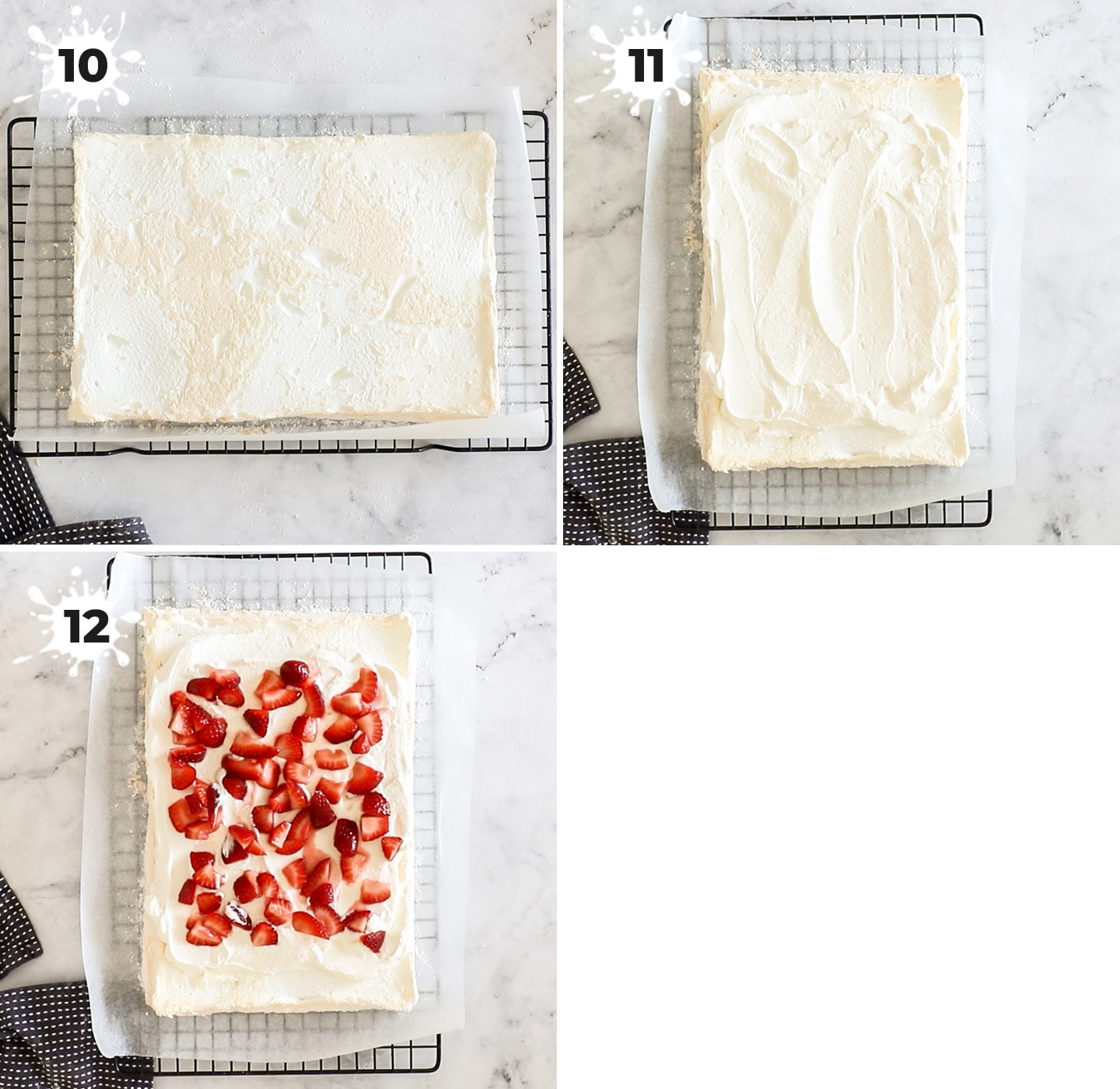
- Spread the chantilly cream (just your cream whipped with the sugar and vanilla) over the roulade, keeping some back for the topping. Make sure to leave an inch clear at each short end (photo 11) – this will make rolling it easier.
- Scatter some of the strawberries over the top (photo 12) but hold back any syrup they’ve created. That can be used at serving time.
Rolling it up
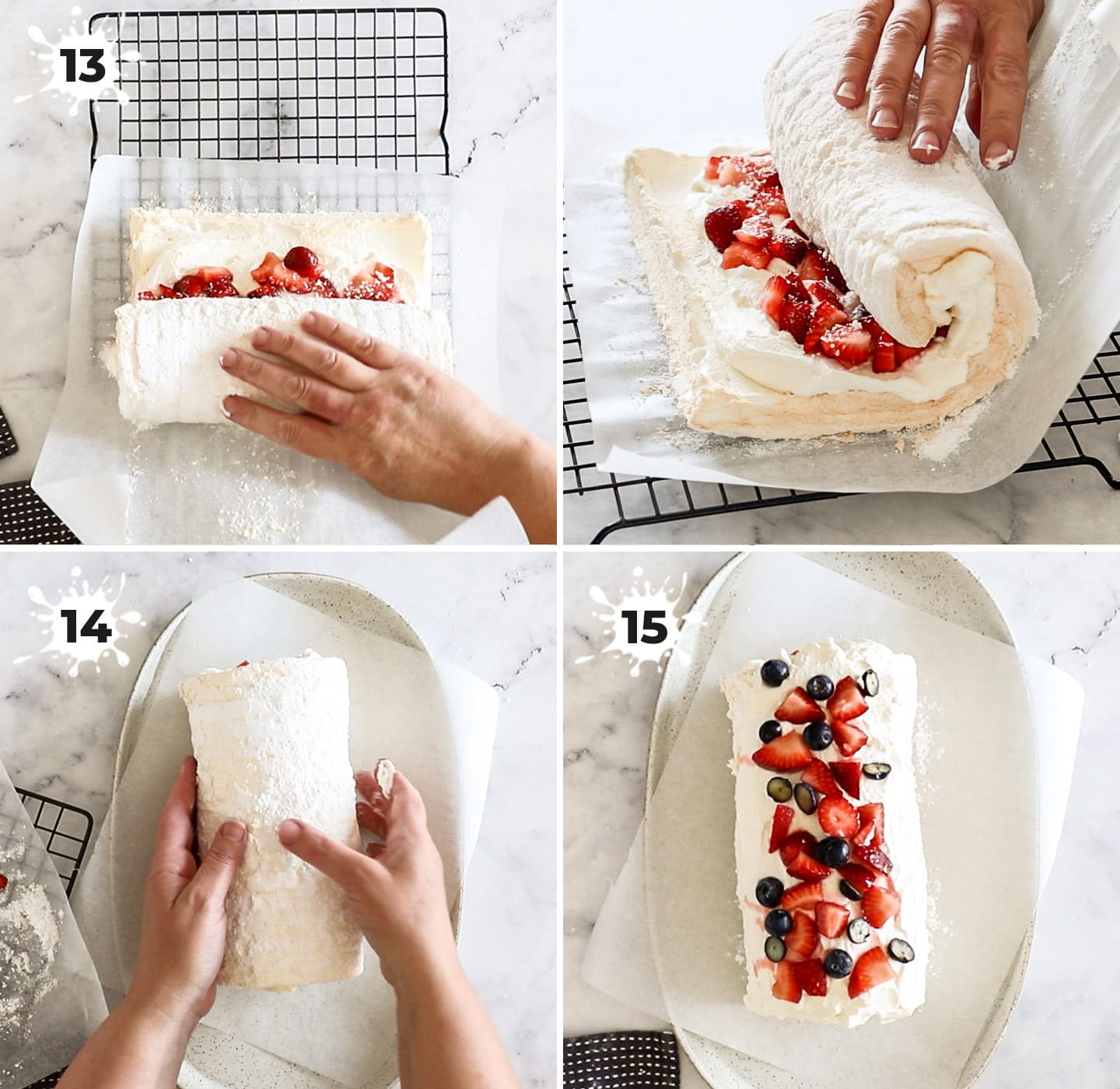
- Use the edge of the paper at the short end closest to you to help you lift and roll over the top of the meringue. Now just use a combination of both to help you roll it all the way up (photos 13). Be very gentle but be confident.
- Carefully lift it up – it should be firm and secure enough to just lift with two hands – and transfer to your serving platter (photo 14).
- Top the pavlova roulade with more cream and berries (photo 15), but again reserve that syrup until serving time.
- Serve immediately.
If you aren’t ready to serve straight away, leave the topping off until you are. Wrap it well in plastic wrap and keep it in the fridge for 4-5 hours prior to serving.
Why did my roulade crack
Don’t be concerned if your meringue roulade gets cracks as you roll it. It will still taste beautiful. Cracking can happen easily since the meringue itself is so delicate. Cracking can be but is not always caused by overbaking. It could also be caused by not having enough filling so don’t skimp on that cream as it actually helps support the meringue.
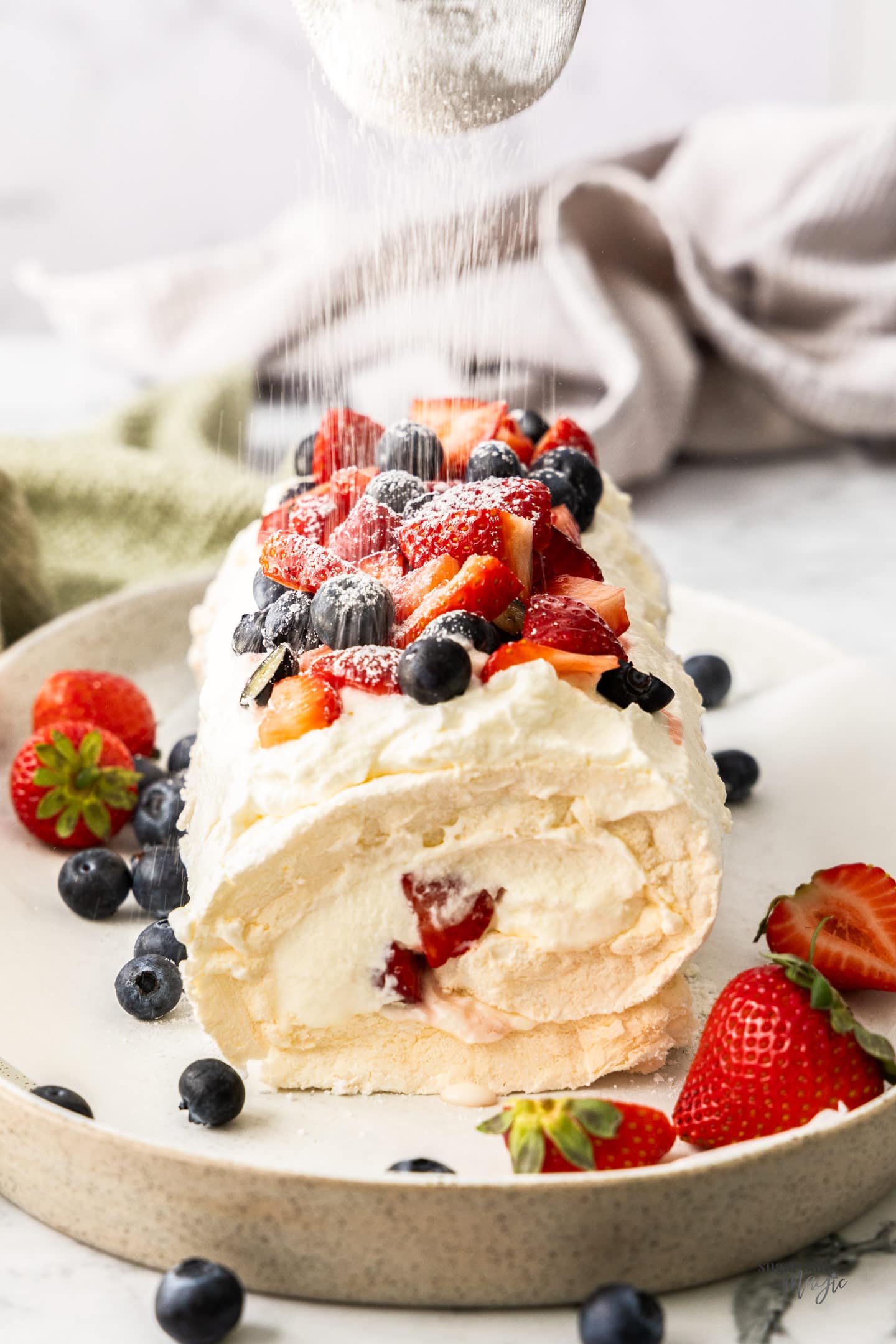
Tips and tricks
- Make sure your equipment is spotless: Any traces of fat or egg yolk in your egg whites can stop them from whipping properly. They’ll still whip but you won’t get them to that stiff peak stage you need for meringue.
- Don’t overwhip but make sure it’s not grainy: You want the meringue to be perfectly smooth, not grainy before putting it into your pan. If it’s grainy but already at stiff peaks, just keep beating on medium so you don’t beat it too far. Adding the vinegar at the end can help smooth out some of those grainy bits too.
- Try any fruits you like, even winter fruits for a winter dessert like poached pears or cinnamon apples.
- Serve within hours of making the meringue. The longer the meringue sits, it will dry out and that can lead to excessive cracking.
- If it does crack, just serve it in small dishes, eton mess style.
- Use a sharp knife to cut the pavlova roll so that everything doesn’t squish out.
- Use leftover egg whites to make pastry cream, lemon curd or even hollandaise sauce.
FAQs
Literally just their form and cooking style. A pavlova is meringue piled up then baked at a low temperature until the outside is crisp and the inside is soft. A roulade is that same meringue but baked in a flat pan then rolled up. It doesn’t have the crisp exterior of a pavlova and is the same texture as the inside of a pavlova.
An eggy flavour is most often due to the sugar not being beaten into the meringue properly or from cutting down the sugar. If some of the sugar is left undissolved it won’t be fully immersed into the egg whites. Similarly, if you cut out any of the sugar called for in the recipe, you’re reducing the sweetness to egg flavour.
While you can make the roll a day ahead (untopped), I find pavlova roll is best served within hours of making. Sometimes the cream can lose a little air overnight and you’ll find the pavlova roll my sag or split a bit overnight. Of course if it starts breaking apart, you could just turn it into an eton mess of sorts. If you do make it a day ahead, wrap it well in plastic wrap and store in the fridge overnight.
Storage
I do find this is best served fresh (see my notes in the FAQ’s section above) however you can store it in the fridge, covered well, overnight. The only risk is the cream beginning to loosen over time which can cause the pavlova roll to sag and maybe crack.
Leftovers can be stored in an airtight container in the fridge.
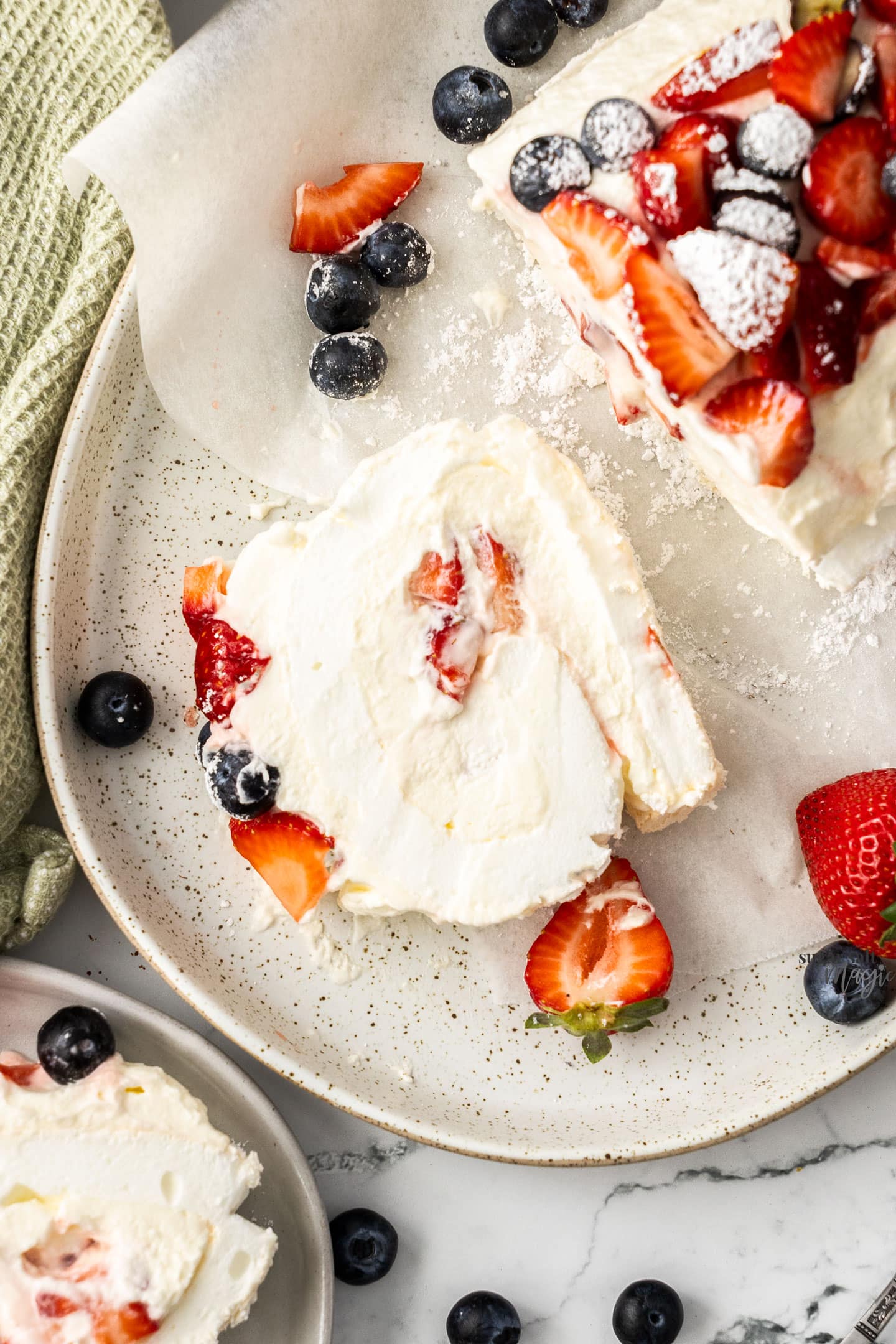
Did you try this pavlova roll recipe?
Leaving a rating and comment below the recipe is so helpful!
Hungry for more? Subscribe to the newsletter for free recipes straight to your inbox. Also, follow along on Facebook, Pinterest and Instagram.
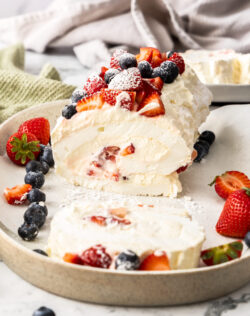
Ingredients
- 4 egg whites (from large eggs), room temperature
- 1 cup caster sugar (superfine sugar) (200g / 7oz)
- 2 teaspoons cornflour (US cornstarch)
- 1 teaspoon white vinegar
- ⅓ cup icing sugar (powdered sugar), divided in two halves (43g / 1 ½oz)
- 250 g fresh strawberries, hulled and sliced (~9oz)
- 1 tablespoon caster sugar, extra (optional) (notes 1)
- 300 ml whipping cream (heavy whipping cream), cold (1 ¼ cups)
- 2 teaspoons vanilla extract
- a handful blueberries
For best results, always weigh ingredients where a weight is provided
Equipment
- 9×13 baking pan (22x33cm)
Instructions
- Make the meringue:Grease and line a 9×13 inch pan (jelly roll pan / swiss roll tin) with ends of paper sticking up. Preheat oven to 160C (140C fan forced) / 320F.
- In the bowl of a stand mixer, with the whisk attachment (or using a handheld beater), beat the egg whites on medium until soft peaks form. About 5 minutes.
- Turn the mixer down to low-medium and begin adding the 1 cup of sugar, one tablespoon at a time, counting to 10 between each addition. Once all the sugar is added, increase the speed to medium-high speed (not highest setting) and continue to whisk until the egg whites are thick and glossy and at stiff peak stage (about 10 minutes).
- Test the meringue mixture by rubbing a little between your finger and thumb. It should be smooth. If it is still grainy, keep beating on medium until it is smooth when you test it.
- Sift over the corn flour and add the vinegar. Whisk for 30 seconds to incorporate it in.
- Use a spatula to scoop the meringue out onto the lined pan. Use an offset spatula to gently spread it out evenly getting into all the corners and so the top is flat and level.
- Bake for 15 minutes until the meringue is just starting to turn the slightest bit golden on top.
- While it’s baking, get a sheet of baking paper (larger than the meringue pan), a small sieve, half of the icing sugar and a wire cooling rack at the ready.
- As soon as you remove the meringue from the oven, sift the 2 tablespoons of icing sugar over the top of the meringue coating it generously. Lay the sheet of baking paper over the top, then the wire cooling rack, upside down on top of that. Take a tea towel or oven gloves so you don’t burn your hands and flip the whole lot over, so the rack is on the bottom and the pan on top. Now simply lift away the pan, then gently peel the baking paper off the meringue top.
- Let the meringue cool for 20-30 minutes or until completely cooled.
- Macerate the strawberries (optional): In a medium bowl, mix the sliced strawberries with the 1 tablespoon of caster sugar. Set aside, giving them a stir every so often.
- In a medium bowl with and electric mixer or a balloon whisk, beat the cold cream, remaining icing sugar and vanilla together until stiff peaks. Don’t overbeat or it will turn grainy.
- Spread ¾ of the whipped cream over the cooled meringue leaving about 1 inch from each short end clear. Dot over about ⅔ of the strawberries leaving any syrup behind (as this will seep out of your roulade).
- Roll the meringue quickly and confidently, using the paper to help, from short edge to short edge and transfer to a serving platter.
- Top with the remaining cream, strawberries and blueberries. Save any strawberry syrup (if you macerated them) to pour over on serving.
- Please take a moment to leave a comment & rating. It's appreciated and so helpful.
Notes
- Tablespoons: I use a standard Australian 20ml tablespoon (equal to 4 teaspoons). Check yours before measuring.
- All ovens vary – if you notice it turning golden too early, the oven may have hot spots. It’s worth keeping an oven thermometer in your oven at all times.
- Fresh egg whites will give a better result than older ones by giving a more stable meringue and making it more malleable to roll.
- Don’t use icing, powdered, granulated or brown sugar in the meringue. Only caster / superfine so that it dissolves without overbeating the egg whites.
- For topping ideas, use whatever fruit is in season. Strawberries, kiwi fruit, passion fruit, mango, raspberries are all classic pavlova toppings, but you could also use blueberries, blackberries, lemon or lime zest, slices citrus fruits.
- Nutrition details are approximate only – scroll below the recipe to find the full nutritional information.
This post may contain affiliate links that earn me a small commission for my referral, at no extra cost to you. Thank you for supporting Sugar Salt Magic.

